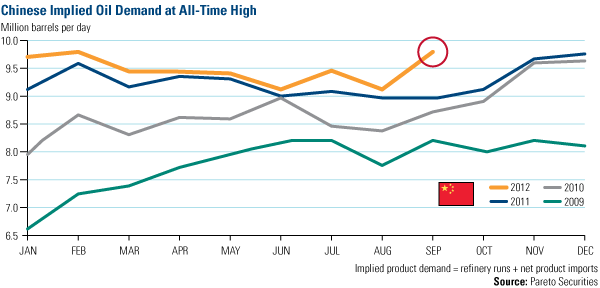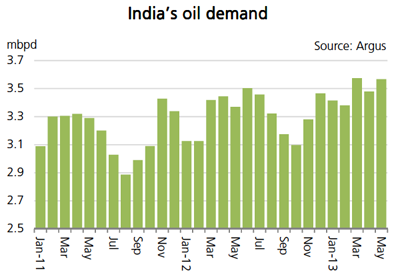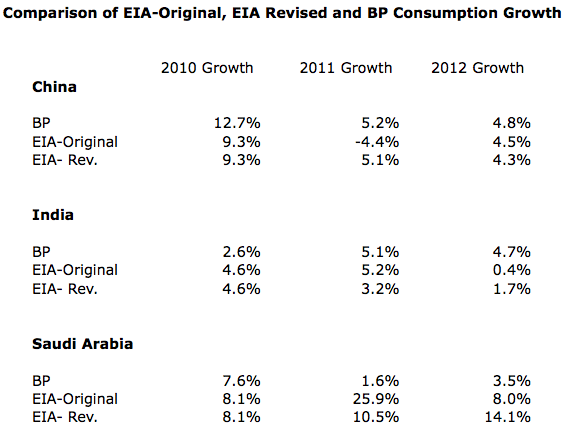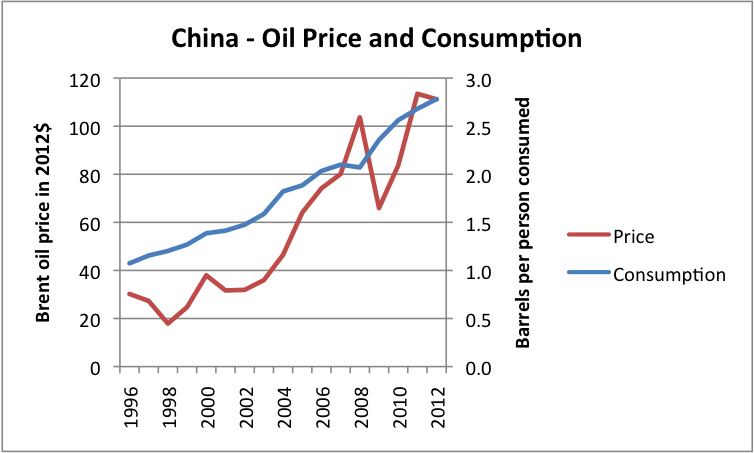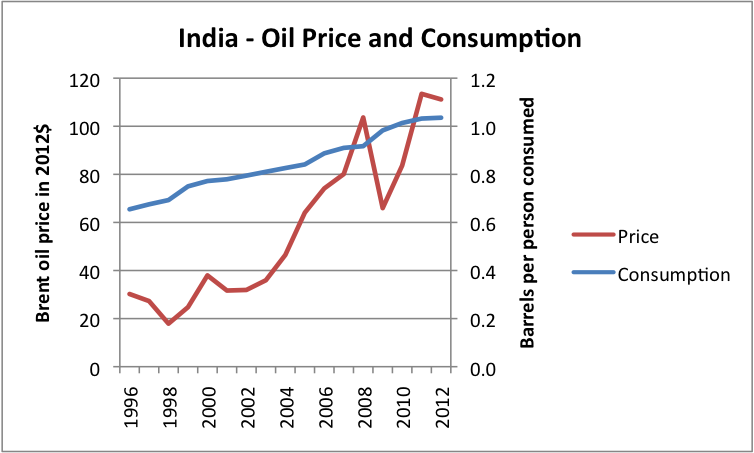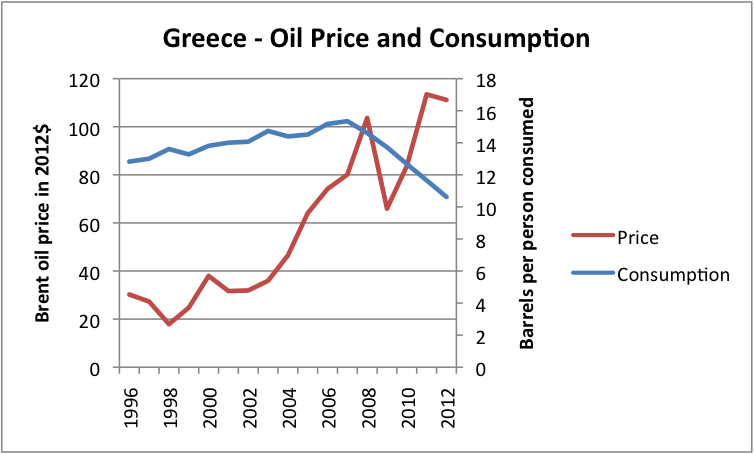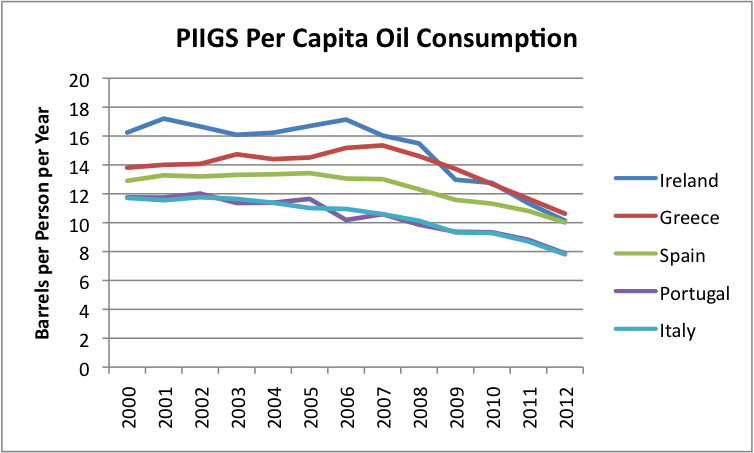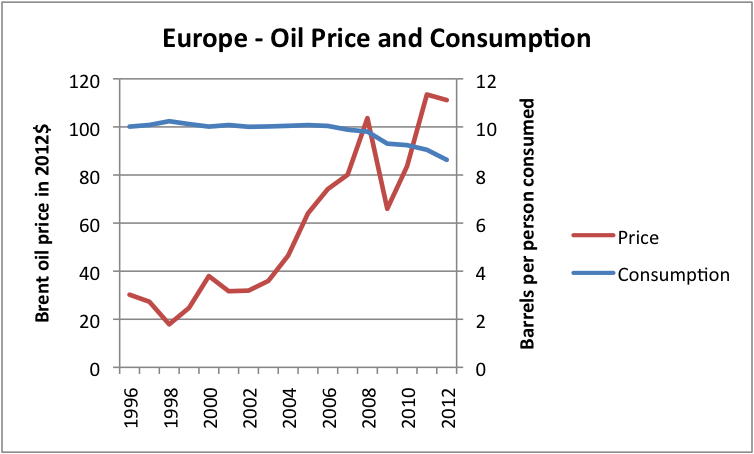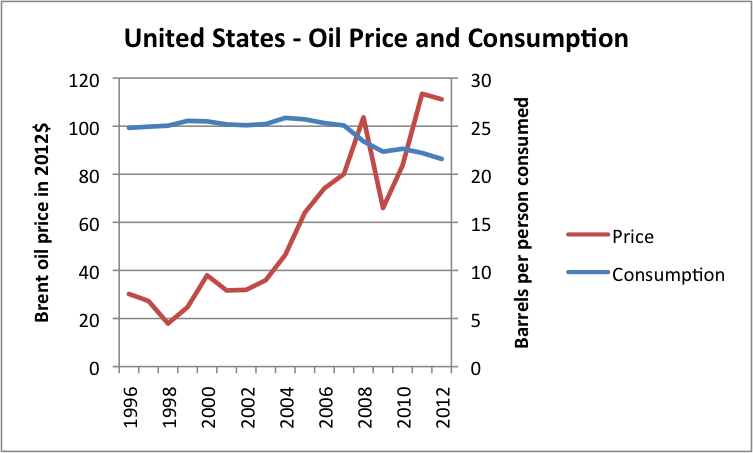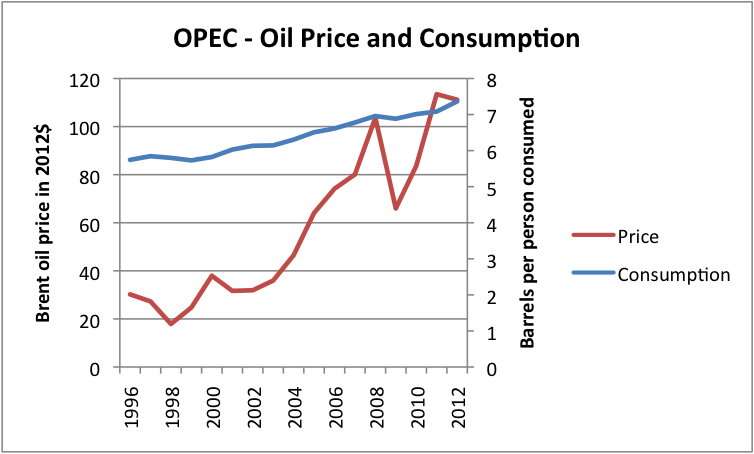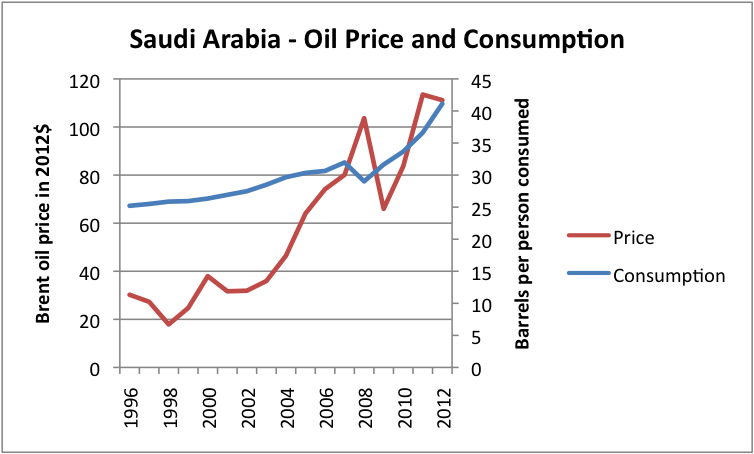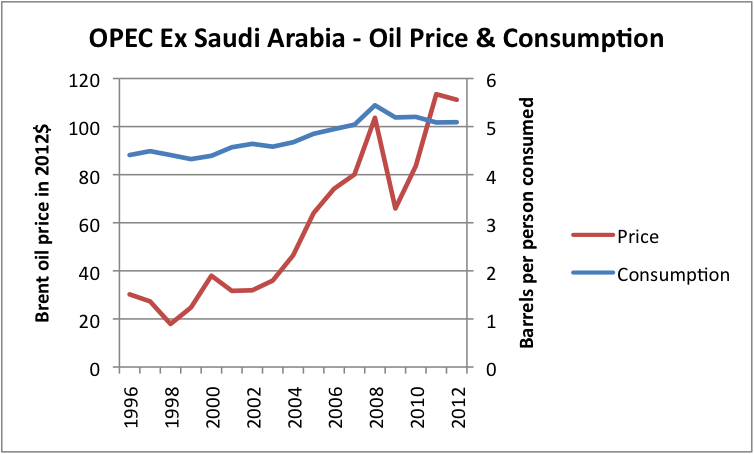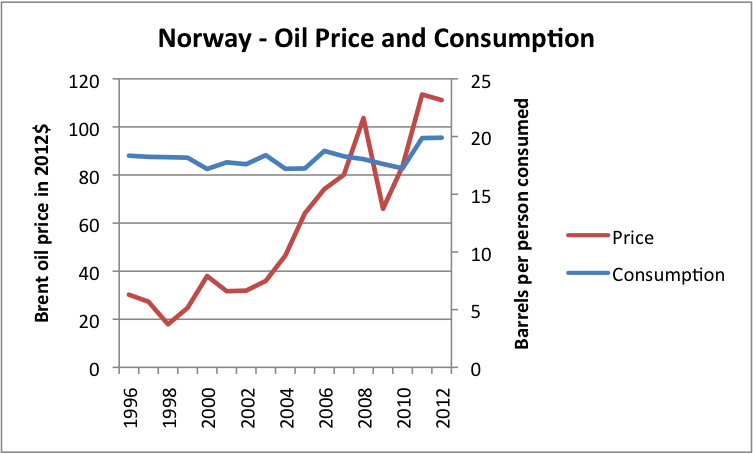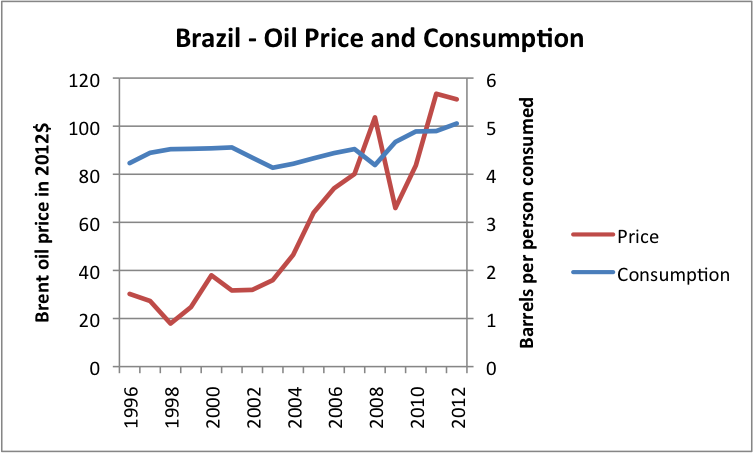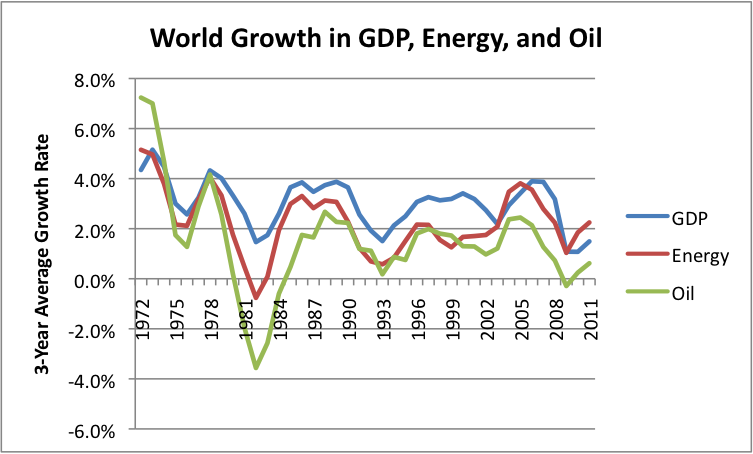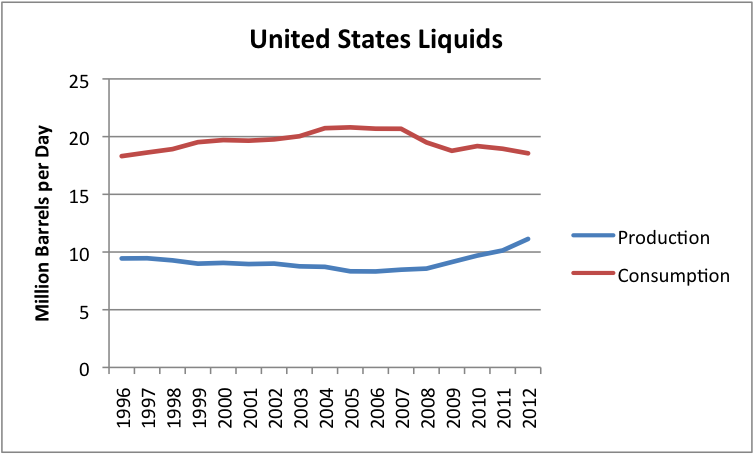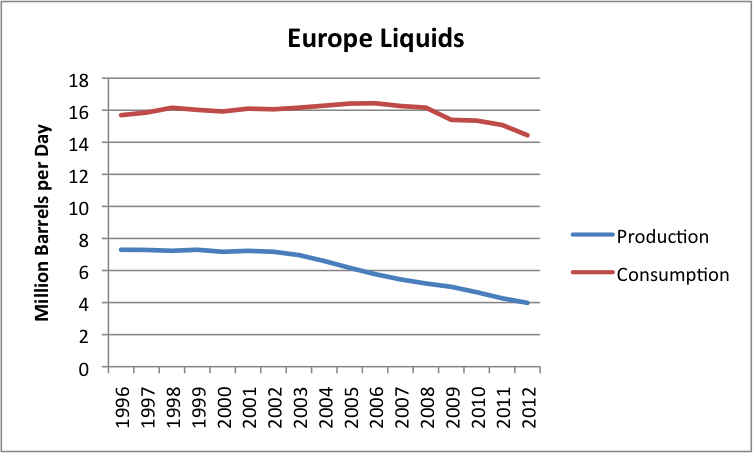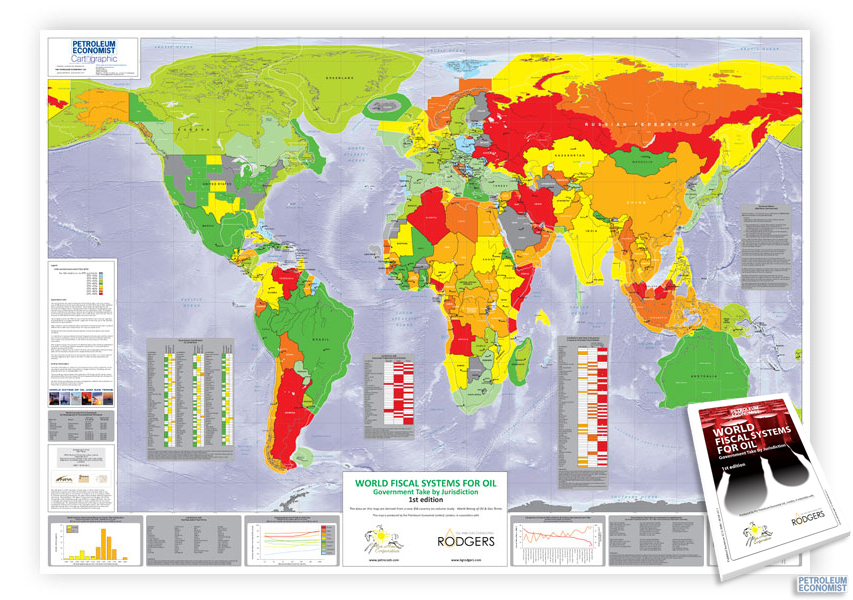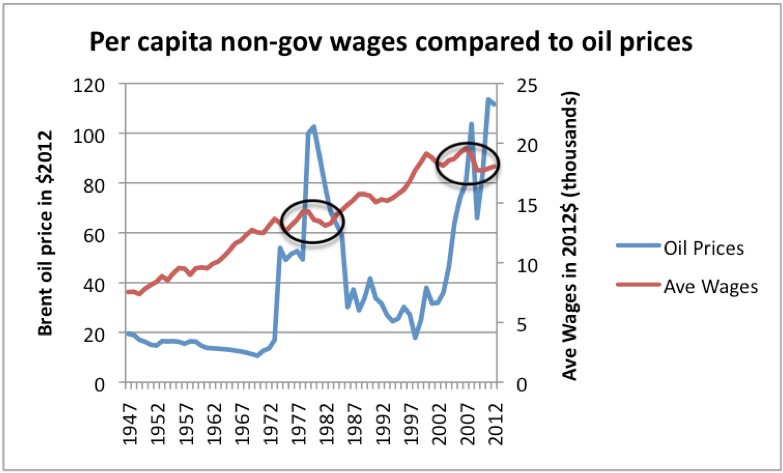On this page we will concentrate on future oil demand from emerging markets.
For our page on oil price estimates for 2020 until 2035 click here.
For our entry on shale oil and oil sands production, break-even and transport costs click here.
Chinese oil demand
2012-2013 figures
Chinese oil demand remained close to 10 mln. bpd (barrel per day) in each month of 2013.
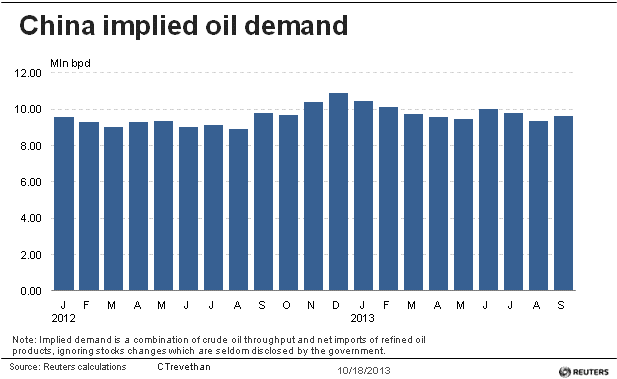 2009-2012 figures
2009-2012 figures
Price movements of other commodities in combination with global commodity demand. We think that global growth, in particular in emerging markets, will resume once risk aversion and high inflation in emerging markets have calmed down. A recovery of the European economies, in particular of Germany, will help to improve global growth.
Brent oil prices seem to be currently depressed more because of seasonal Chinese demand weakness than due to the increased U.S. supply and the new fracking techniques.Chinese oil demand alone typically rises by 5-9% per year or an average of 1.0 million barrels per day (Mb/d), while shale oil in the U.S. could reach a maximum production of 2 to 3 Mb/d by 2035 and currently produces 0.9 Mb/d. The weaker Chinese GDP growth of 7.7% is still high enough to support 5-9% oil consumption increase. Hence over the long-term Brent oil prices should rise again. This is positive for gold, silver and other commodities. Non the less, we recommend gold investors to understand oil price cycles, the mechanisms of oil supply and demand.
Indian oil demand
Oil consumption in different countries
Update: Not long after I wrote this post, the EIA revised the oil consumption amounts by country that they had published a few days earlier. The numbers changed substantially for quite a few of the countries outside the US and Europe. While the trend is still to lower growth in oil usage in 2011 and 2012 in China and India than in 2010, the trend is less pronounced.
Furthermore, we now have another set of numbers to check against EIA’s oil consumption amounts. BP released Statistical Review of World Energy 2013 yesterday, June 12. A comparison of annual increases in oil consumption (on a barrels of oil per day basis, not adjusted for population growth) from the three sources is as follows:
There seems to be fairly consistent reporting of oil consumption for major OECD countries, but this is less the case for non-OECD countries. The lack of stability in reported oil consumption, both between reporting organizations and between reports, suggests that oil consumption numbers have “large error bands” around them. Below is a revised version of my original post.
Revised post. Based on revised EIA data, it appears that at current high oil prices, oil demand the United States and Europe is being reduced. There are some indications that oil demand in China and India are flattening, but these are preliminary. For those who are wondering how high oil prices need to be, to be “too high,” the answer is, “We are already there, for the United States and Europe. We are getting there for China and India. In fact, continued high oil prices are a big reason behind the recessionary forces we are now seeing around the world.”
China and India, like the United States and most of Europe, are oil importers. Over time, we should expect high oil prices to have an impact on all importers. While the original EIA data suggested that China and India were affected in 2011 and 2012, the impact is much more muted using revised data.
In this post, I also explain why a person might expect a difference in the impact of high oil prices on oil importing countries compared to oil exporting countries.
We can see from Figures 1 and 2 that at $100 per barrel prices, there is a flattening in per capita consumption, particularly for India. Per capita consumption is used in this analysis, because if total oil consumption is rising, but by less than population is increasing, consumption on average is falling.
Some Other Countries with Declining Consumption
There are many other importing countries with sharper drops in consumption than China and India. These declines started in the 2005 to 2007 period, as oil prices rose, and continued as oil prices have remained high. One example is Greece. [Note-European amounts did not change with the revision in EIA oil consumption amounts.]
In fact, all of the PIIGS (Portugal, Ireland, Italy, Greece, and Spain, known for their problems with recession) have shown steep drops in oil consumption:
Europe in total shows a somewhat less steep drop in oil consumption than the PIIGS:
The US shows a similar drop in consumption to Europe:
Where is per capita oil consumption rising?
Oil consumption is rising faster than population in quite a few oil exporting countries. If we look at OPEC in total, we see an increase in per capita oil consumption particularly in 2008 and 2012.
According to revised EIA data, the increase in consumption is solely from Saudi Arabia.
For Saudi Arabia, 2012 oil consumption per capita is nearly five times as much as that of Europe. Outside Saudi Arabia, the original EIA data showed a definite upward bump in consumption, both during the 2008 price run-up and corresponding to the higher price in 2011 and 2012. With the revised EIA data, per capita consumption is still shows an upward bump in 2008, but is down in 2011 and 2012. Unfortunately, BP does not put together data in the detail necessary to monitor OPEC oil consumption in total.
One reason why oil exporters might be expected to show higher growth in oil consumption than other countries is because oil is becoming more difficult to extract, and because the easiest to extract oil was extracted first. There are often indirect needs for oil as well, such as desalinization to have sufficient water for a growing population, or a new refinery for difficult-to-refine oil. I talk about these issues in my post, Our Investment Sinkhole Problem.
A second reason why oil exporters often show higher growth in oil consumption is because exporters often provide subsidized prices on oil products, so their citizens do not have to pay the full cost of the product. Thus, their citizens do not really experience the high oil prices that most importers do.
A third reason why oil exporters show higher growth when oil high prices are high has to do with all of the money these exporters receive when they sell high-priced oil. The Economist recently had an article “Saudi Arabia risk: Alert – The next property bubble?” It talks about the huge number of office buildings, schools, low-priced homes, and other building projects underway, thanks to a combination of easy credit availability and lots of oil money. The article indicates that citizens rarely put their new-found wealth into paper investments. Instead, a significant part of their wealth ends up in building projects that require oil use.
Norway is an exporter that does not subsidize oil prices (in fact, it has quite a high tax on oil use in private vehicles). It shows higher per capita oil consumption in the past two years, despite higher world oil prices.
Brazil is not an oil exporter, but it has been trying to ramp up its production. Its per capita consumption has been slightly rising recently. Earlier EIA data showed more of a rise in Brazil’s consumption.
In fact, Central and South America in total and the Middle East in total show oil consumption rising faster than population, in 2011 and 2012. These are areas that, in total, are oil exporters.
Some very low oil-use countries, such as Bangladesh, are showing rising per capita oil consumption in 2011 and 2012, even with higher oil prices. This could indicate that some manufacturing is shifting to even lower cost areas than China and India.
Australia is showing growing per capita oil consumption, perhaps because of oil’s use in resource extraction and transport.
Why would a drop in per capita oil consumption for oil importers matter?
A drop in per capita oil consumption is a likely sign that oil is becoming increasingly unaffordable. We know that oil is used to make and transport goods. If less oil is used, or if oil use is growing less rapidly than in the past, there is a real chance that an economy is slowing.
There are a number of reasons why oil consumption may be down. Fewer goods for sale may be being transported, perhaps because European demand is down. Citizens may be driving less in their free time. Or many young people may be unemployed, and be unable to afford to buy a car or motor scooter. Any of these changes could mean a slowing economy.
Obviously, there are situations in which reduced oil consumption doesn’t mean a slowing economy. A shift from manufacturing to a service economy could lead to lower oil consumption; a shift toward more fuel-efficient cars and trucks could lead to lower oil consumption. But these changes tend to take place slowly over time, not all at once, when oil prices rise.
Another way oil consumption can be reduced is if a country has in the past generated electricity using oil, and such generation is shifted to another fuel, such as natural gas. This type of change is being made in Greece, but seems unlikely in China and India. Similarly, if homes are heated with oil, sometimes an alternate fuel can be used, reducing oil consumption. China and India aren’t areas where oil has traditionally been used to heat homes, though.
In general, though, sharp reductions in oil consumption in a growing economies, such as China and India, are cause for concern, if one was expecting growth. Are high oil prices stressing the economy?
United States and European Oil Imports
The US oil consumption pattern looks very much like that of an oil importing nation, under stress from high oil prices. Recently, there has been a lot of publicity about higher US oil production, but this does not really change the situation. If we look at US oil consumption and production (actually “liquids” production and consumption since all kinds of stuff including biofuels are included), we see that the US remains an oil importer. In fact, it is still a long way from becoming an oil exporter. (And, importantly, oil prices aren’t down by much, and high oil prices are our real problem.)
The European oil import situation is worse than the United States liquids situation, and no doubt contributes to its current economic problems. A graph of its recent production and consumption is as follows:
Difference Between Oil Importers and Exporters – Additional thoughts
The cost of extraction varies widely by country and by field within country. In order to provide a large enough quantity of oil in total, the world price of oil has to be high enough to provide an adequate profit for the highest cost producer. Clearly, if every oil company charged the price needed for the highest cost producer, many would be collecting far more than they need for future oil extraction and payment of dividends. Where does all of this extra money go?
To a significant extent, this money is “latched onto” by governments. In the case of oil exporting countries, governments often own oil companies directly. But even if they don’t, governments tax oil extraction at very high rates, to make certain that the government gets the benefit of any extra revenue available. Sometimes Production Sharing Agreements are used. A chart by Barry Rodgers Oil and Gas consulting (Figure 15 below) shows that for many oil exporting countries, the government “take” is 70% to 90% of operating income (that is, net of direct expenses of extraction).
Even in the case of the United States, the government take is significant. Barry Rodgers, in an article in the May issue of Oil & Gas Journal, calculates that for tight oil (such as oil from the Bakken), the average government take is $33.29 per barrel. This compares to $19.50 per barrel, for tight oil extracted in Canada. These amounts include payments to state governments as well as the federal government. If extraction costs are low, as in the case of Alaska, the state adjusts its tax accordingly.
Oil importing countries would like the world to have a level playing field with respect to the price of oil. In the real world, this doesn’t happen. Oil exporting countries get huge benefits in the form of the tax they collect from the oil they sell abroad. Often, this tax revenue amounts to 70% or more of a country’s tax budget from all sources. If oil exporters have small populations, they can afford to offer oil at subsidized rates to their own populations. (If they have large populations relative to exports, offering a subsidized price would soon eliminate all exports!)
Economists would like us to believe that many of the differences between oil exporters and oil importers will even out because money spent by oil exporters to purchase goods and services together with purchases of government bonds from oil importers should mostly make their way back to oil importing countries. There are several differences though:
(a) Oil exporting countries can choose to charge their citizens a lower price oil, thus insulating them from the high world oil price, and raising their demand for oil (that is, the amount of oil they can afford). This higher demand allows these countries to increase their oil consumption, even as other countries, subject to higher prices, reduce theirs. Evidence presented in this article suggests that this, in fact, is happening at high prices.
(b) Oil exporting countries need not tax the income of individuals and businesses, or institute value added taxes, because their tax needs are mostly met by the taxes they collect on oil that is exported. This gives them a competitive advantage in making goods from oil or natural gas for international trade.
(c) Since world oil supply is limited, the oil that the oil exporting countries are able to purchase at subsidized prices (even if to build unneeded office buildings in Saudi Arabia) is removed from the world market, further driving up oil prices, and leaving less for other countries to consume.
(d) The money that is spent by oil exporters rarely makes it back to the salaries of individuals in oil importing nations who are faced with buying high-priced oil products. In fact, I have shown that in times of oil prices, Unites States salaries tend to stagnate:
At best, the money makes it back to financial institutions and corporations selling products such as exported grain. The higher demand for grain tends to raise food prices, putting another stress on the economy.
About Gail Tverberg
My name is Gail Tverberg. I am an actuary interested in finite world issues – oil depletion, natural gas depletion, water shortages, and climate change. Oil limits look very different from what most expect, with high prices leading to recession, and low prices leading to inadequate supply.
See more for








